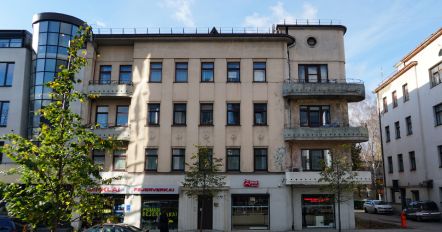
Summerhouse of engineer E. Venckiavičius
2019 October 23
Residential house
2019 November 2Dentist’s house
Modernist twentieth-century rhetoric often mentioned essential concepts such as hygiene, cleanliness, natural light, fresh air, and open spaces. Many of them applied not only to architecture, but also to lifestyle norms in general:
“Snow-white teeth and a pleasant mouth odor guarantee you success. By systematically using Florance’s Miradont paste, you will achieve your goal. Miradont paste has been improved with the latest technical and hygienic words.”
This is just one of many fragments of interwar advertising that appeared in the Lithuanian press at that time. Numerous young women and men in the ads seduced the customer with world’s most beautiful hair, teeth, skin, smile, socks, shoes, suits, shaped the needs of consumers and called for constant care for their image.

Illustrations from the interwar newspappers. Source: „Tarpukario Lietuvos reklama“ (sud. Ramūnas Minkevičius), 2015 m.
Therefore, it seems that there was no shortage of work for the character of our story – dentist Janina Rožanskienė (1897–1983). She was one of those tireless interwar Lithuanian women engaged not only in work practice, but also in active social activities. Janina belonged to the Lithuanian Dental Association founded in 1932, and in the house built on A. Mickevičiaus Street in 1939 she not only lived, but also practiced as a private dentist. No less interesting is the fact that the doctor took care not only of the beauty of her patients’ mouths, but also of the representation of the street where the house stood. The widely documented request of the owner to plaster a wooden house, that stood on the site of the present house before, has survived in historical documents. The owner argued that the street is one of the most representative in Kaunas and its’ buildings are what makes it look even more beautiful. Although there were dozens of brick buildings on this street, there were still many wooden houses. So she stated that she would like to contribute to the work of beautifying the city by plastering the house that belonged to her.

Facade of the building, arch. A. Jokimas, 1939. Source: KAA, f. 218, ap. 2. b. 4802, l. 34. Photo source: Architektūros ir urbanistikos tyrimų centras.
However, in 1939 she decided to build a new brick four-storey house. The house housed seven luxury apartments with rooms for maids. But, unfortunately, it did not last long. After the occupation and the war, Janina Rožanskienė left Lithuania and settled in America, Mt. Prospect, Illinois, where she died in 1983. Meanwhile, the doctor’s house still stands in Kaunas, on the same A. Mickevičiaus Street, as if a silent witness to the owners’ efforts not only to care for patients’ teeth, but also to take care of the beauty of the city streets.
Text by Žilvinas Rinkšelis
Photos by Ž. Rinkšelis, 2019.

